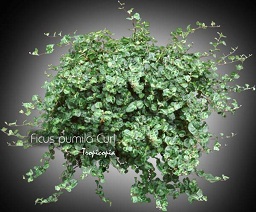Table of contents
Creeping fig

Latin Name: Ficus pumila ‘Curl’
Category: Ficus
Family: Moraceae
Origin: Cultivar
Climate: Tropical
Growing Zones: 11-10
Care Instructions
The Creeping fig (Ficus pumila ‘Curl’) is a tropical plant that originates from Cultivar. This ficus plant belongs to the Moraceae family and is well-suited for growing in USDA zones 11-10.
Complete Care Guide for Creeping Fig (Ficus pumila ‘Curl’)
Watering Requirements
The Creeping Fig, or Ficus pumila ‘Curl’, thrives best with consistent moisture but is sensitive to overwatering. It is essential to allow the top inch of soil to dry out between waterings. During the growing season, typically spring and summer, water the plant thoroughly once a week. In the fall and winter months, reduce watering frequency, as the plant enters a dormant phase and requires less moisture. Always check the soil moisture level by inserting your finger into the soil; if it feels dry, it’s time to water. Ensure that the pot has good drainage to prevent root rot, which can be detrimental to the health of your Creeping Fig.
Light Conditions
Creeping Fig prefers bright, indirect light but can tolerate low light conditions. However, for optimal growth and to maintain its vibrant foliage, it is best to place it in a location where it can receive filtered sunlight. Direct sunlight can scorch the leaves, leading to browning and damage. If grown indoors, a spot near a window with sheer curtains is ideal. If you notice the plant becoming leggy or the leaves losing their vibrant color, it may be a sign that it needs more light. Conversely, if the leaves are turning yellow, it might be receiving too much direct sunlight.
Soil Preferences
The ideal soil for Creeping Fig is a well-draining potting mix that retains some moisture without becoming soggy. A mixture of peat moss, perlite, and regular potting soil works well. This combination allows for adequate aeration and drainage, which is crucial for the health of the roots. Fertilization should be done during the growing season with a balanced, water-soluble fertilizer every 4-6 weeks. In the fall and winter, reduce or eliminate fertilization as the plant’s growth slows down. Always ensure that the pot has drainage holes to prevent water from accumulating at the bottom, which can lead to root rot.
Pests and Diseases
Creeping Fig is generally resilient but can be susceptible to common pests such as spider mites, aphids, and mealybugs. Regularly inspect the undersides of leaves and the stems for any signs of infestation. If you notice pests, treat them promptly with insecticidal soap or neem oil, ensuring to cover all affected areas. Additionally, keep the humidity levels moderate, as overly dry conditions can encourage pest problems. Fungal diseases can also occur, particularly if the plant is overwatered or if there is poor air circulation. Signs of fungal issues include yellowing leaves and a white, powdery substance on the foliage. To combat this, ensure proper watering practices and improve air circulation around the plant.
Special Care Tips
To maintain the health and beauty of your Creeping Fig, consider the following special care tips: First, regularly prune the plant to encourage bushier growth and to remove any dead or damaged leaves. This not only enhances its appearance but also promotes better air circulation. Second, if you are growing it as a climbing plant, provide a trellis or support structure for it to cling to, as it naturally adheres to surfaces with its aerial roots. Lastly, be mindful of temperature fluctuations; Creeping Fig prefers temperatures between 60°F and 75°F (15°C to 24°C) and should be protected from drafts and sudden temperature changes. With these care tips, your Creeping Fig will thrive and add lush greenery to your space.








